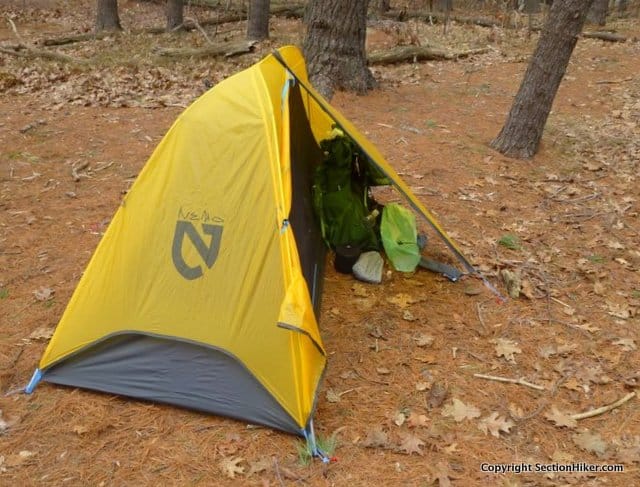
The NEMO Hornet Elite 1 Tent is an ultralight double-wall tent that only weighs 1 lb 7 oz. It's ideal for solo backpacking or bikepacking trips when you need a shelter that packs up small, but provides better wind and weather protection than a bivy sack. Made with thin and lightweight (7 and 10 denier nylon) but conventional fabrics, I would recommend using a tent footprint with this tent to protect the floor from abrasion or pointy objects. There are limits to the durability of ultralight gear and this tent definitely pushes the envelope.
Specs at a Glance
- Weight (total): 23 oz
- Fly: 7.0 oz
- Inner Tent: 8.6 oz
- Pole: 7.4 oz
- Type: double-wall, not free-standing
- Materials: Fly – 7D PeU Nylon Ripstop (1200 mm); Floor – 10D Sil/PeU Nylon Ripstop (1200 mm)
- Inner tent dimensions (pitched): Head width – 40″; Foot width – 31″; Length – 87″; Peak height – 38″
- Minimum stakes to pitch: 5, but using 6 really improves the ventilation.
- Doors: 1
Inner Tent
Sized for one person, the Hornet Elite 1P comes with a single hubbed Y-pole that connects to the inner tent floor at three points, two on the corners of the "head" end and one in the middle of the "foot" end of the tent. While these three arms are enough to hold the up the inner tent, you still need to stake out the four corners of the inner tent to stretch out the corners and help shape the bathtub floor. I recommend staking the corners first (especially in wind), before inserting the pole, which connects to the inner tent with corner clips and plastic hooks on top.

The inner tent is sized for a one person but wide enough to hold a 72″ x 25″ sleeping pad. There's one door, which opens into a side vestibule, which you'll want to store your pack and extra gear to free up more space inside the inner tent. Cross ventilation is quite good provided that you fully stake out the rain fly and leave the door partially unzipped to help prevent internal condensation. A high bathtub floor protects you from cold breezes and helps extend the range of the tent so it can be used in cooler weather.
There are overhead gear loops on the ceiling to hang gear, a mesh pocket near the door, and one overhead pocket, which is designed to hold a headlamp in order to provide ambient light. This isn't a tent to car camp or hang out in with your dog if you're looking for a larger interior space, but for changing your clothes, sitting up inside, reading maps, and sleeping it's just fine.
The inner tent floor is made with a 10 denier Sil/PeU Nylon Ripstop which held up fine when I tested it, but I'd still recommend using a footprint with the Hornet Elite 1. A 75 denier footprint is available for this tent that weighs 5.3 ounces, but you can do much better with a small 2 oz piece of clear plastic insulating window wrap, sized so it's cut a bit smaller than the inner tent floor. Less expensive too.

Rain Fly
The rain fly is a gossamer thin 7 denier marigold-colored PeU Nylon Ripstop, but provides good privacy if you're camped near others. It connects to the four staked corners of the inner tent and maximizes the utility of your tent stakes. The fly requires an additional two tent stakes to fully set up, one to stake out the front vestibule over the door and the other on the opposite side.
The front vestibule is large enough to store a backpack so you can retain easy access to gear at night without having it crowd the interior space, while toggles on the fly let you roll back both sides in good weather. The center zipper is protected against rain with an external storm flap, however there's relatively little lateral coverage near the top of the zipper to prevent you from getting drenched in a heavy rain.

The edges of the rain fly are cut fairly high to channel air up the solid slanted sides walls of the inner tent, while preventing splash-back. While the tent is surprisingly wind worthy, extra guylines and guyout points are provided if you need to secure the tent in heavier weather.
Recommendation
The NEMO Hornet Elite 1 is a great ultralight double-wall backpacking tent for solo trips when light weight and low gear volume are priorities. It's easy to set up and narrow enough to fit into tight spaces when you need to camp at wild, non-designated campsites, but provides far more comfort, weather, and insect protection than a bivy sack or tarp. Weighting just 1 lb 7 oz, the Hornet Elite 1 is mindbogglingly lightweight for a tent made with conventional fabrics, although it is on the pricy side. If cost is an issue, the regular NEMO Hornet 1 is nearly identical, but just 4 ounces heavier, more durable, and significantly less expensive.
Disclosure: NEMO provided the author with a sample tent for this review.
Written 2018.
Disclosure: SectionHiker.com receives affiliate compensation from retailers that sell the products we recommend or link to if you make a purchase through them. When reviewing products, we test each thoroughly and give high marks to only the very best. Our reputation for honesty is important to us, which is why we only review products that we've tested hands-on. Our mission is to help people, which is why we encourage readers to comment, ask questions, and share their experiences on our posts. We are independently owned and the opinions expressed here are our own.The post NEMO Hornet Elite 1 Ultralight Tent Review appeared first on Section Hikers Backpacking Blog.
from Section Hikers Backpacking Blog http://ift.tt/2GaDcLc
No comments:
Post a Comment